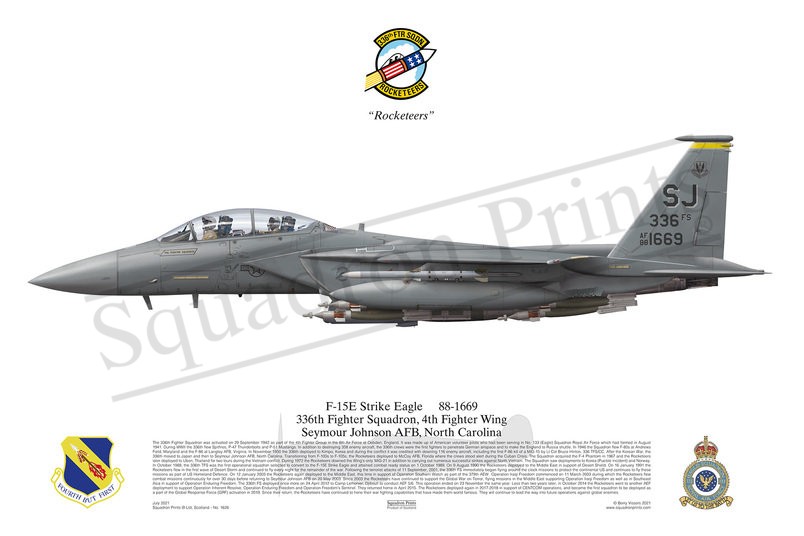#1626 336th FS F-15E Strike Eagle print

Description
Squadron Prints Lithograph No. 1626 - 88-1669 '336 FS', F-15E Strike Eagle, 3336th Fighter Squadron, 4th Fighter Wing, Seymour Johnson AFB, North Carolina.
The 336th Fighter Squadron was activated on 29 September 1942 as part of the 4th Fighter Group in the 8th Air Force at Debden, England. It was made up of American volunteer pilots who had been serving in No. 133 (Eagle) Squadron Royal Air Force which had formed in August 1941. During WWII the 336th flew Spitfires, P-47 Thunderbolts and P-51 Mustangs. In addition to destroying 358 enemy aircraft, the 336th crews were the first fighters to penetrate German airspace and to make the England to Russia shuttle. In 1946 the Squadron flew F-80s at Andrews Field, Maryland and the F-86 at Langley AFB, Virginia. In November 1950 the 336th deployed to Kimpo, Korea and during the conflict it was credited with downing 116 enemy aircraft, including the first F-86 kill of a MiG-15 by Lt Col Bruce Hinton, 336 TFS/CC. After the Korean War, the 336th moved to Japan and then to Seymour Johnson AFB, North Carolina. Transitioning from F-100s to F-105s, the Rocketeers deployed to McCoy AFB, Florida where the crews stood alert during the Cuban Crisis. The Squadron acquired the F-4 Phantom in 1967 and the Rocketeers later deployed to Ubon, Thailand for two tours during the Vietnam conflict. During 1972 the Rocketeers downed the Wing’s only MiG-21 in addition to carrying out numerous successful strikes against North Vietnam. The Squadron saw deployments to Korea (Pueble incident) and Norway. In October 1988, the 336th TFS was the first operational squadron selected to convert to the F-15E Strike Eagle and attained combat ready status on 1 October 1989. On 9 August 1990 the Rocketeers deployed to the Middle East in support of Desert Shield. On 16 January 1991 the Rocketeers flew in the first wave of Desert Storm and continued to fly every night for the remainder of the war. Following the terrorist attacks of 11 September, 2001, the 336th FS immediately began flying around the clock missions to protect the continental US and continues to fly these missions as part of US Homeland Defence. On 12 January 2003 the Rocketeers again deployed to the Middle East, this time in support of Operation Southern Watch as part of the 379th AEW. peration Iraqi Freedom commenced on 11 March 2003 during which the Rocketeers flew combat missions continuously for over 30 days before returning to Seymour Johnson AFB on 20 May 2003. Since 2003 the Rocketeers have continued to support the Global War on Terror, flying missions in the Middle East supporting Operation Iraqi Freedom as well as in Southeast Asia in support of Operation Enduring Freedom. The 336th FS deployed once more on 24 April 2012 to Camp Lemonier, Djibouti to conduct AEF 5/6. This operation ended on 23 November the same year. Less than two years later, in October 2014 the Rocketeers went to another AEF deployment to support Operation Inherent Resolve, Operation Enduring Freedom and Operation Freedom’s Sentinel. They returned home in April 2015. The Rocketeers deployed again in 2017-2018 in support of CENTCOM operations, and became the first squadron to be deployed as a part of the Global Response Force (GRF) activation in 2019. Since their return, the Rocketeers have continued to hone their war fighting capabilities that have made them world famous. They will continue to lead the way into future operations against global enemies.
You may also like
-
SALE RIAT 2016 Print F-35B, F-16C, DHC-1, Typhoon, PC-9M
ZM137; 4055; G-AKDN; ZK356; 54RIAT 2016RAF Fairford
